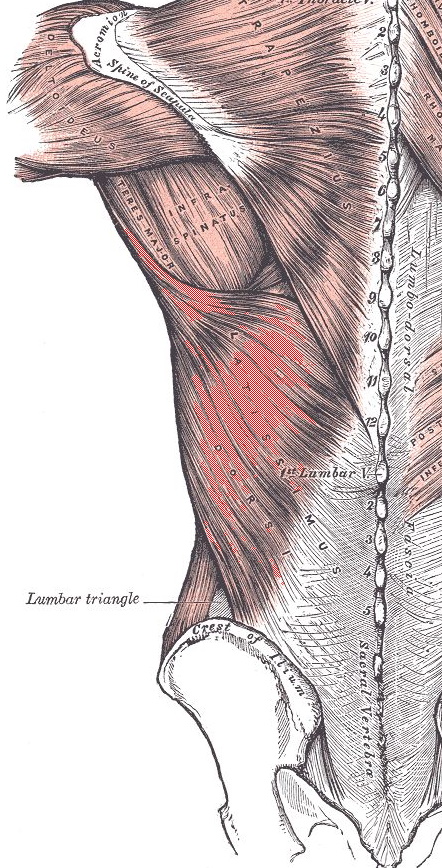yogabook / muscles / latissimus dorsi

Linkmap

Latissimus dorsi
the large lateral back muscle, usually consisting of 4 parts (pars scapularis may be missing), a truncohumeral muscle of the shoulder girdle:
- pars vertebralis: originates at the 7th-12th thoracic vertebrae
- pars iliaca: originates from the posterior third of the iliac crest and the fascia thoracolumbalis and
- pars costalis: rib portion
- pars scapularis: part of the shoulder blade, this head is scapulohumeral
the 4 parts attach to the upper front of the upper arm and work together during lateral adduction and frontal adduction of the arm. They also pull the shoulder blades backwards(retraction) and downwards(depression), participate in forced exhalation (e.g. when coughing) and, depending on the position of the arm, cause it to endorotate to a greater or lesser extent. Because of the movements it causes, it is also known as the „tail pocket muscle“ or „apron muscle“.
It lies deeper than the trapezius and forms the posterior axillary arch together with the teresmajor, which also adducts and endorotates. The latissimus dorsi is one of the expiratory respiratory muscles.
Origin: spinous processes of the lowest 6 thoracic vertebrae and all lumbar vertebrae, fascia thoracolumbalis, ilium (labium externum of the crista iliaca), lowest 3 or 4 ribs, lower angle of the scapula, back of the sacrum
Attachment: Crista tuberculi minoris on the front of the humerus
Innervation: Nervus thoracodorsalis from Pars infraclavicularis of the plexus brachialis (C6-C8)
Antagonists:
Movement: lateral adduction and frontal adduction, endorotation, lateral flexion of the spine, expiratory auxiliary muscle, especially with its pars vertebralis: mediate retraction of the scapula
Strengthening postures (502): caturkonasana, downface dog: with feet turned upside down, upface dog: with feet turned upside down, trikonasana – when the latissimus is engaged to eliminate the lateral curve of the spine, as well as ardha vasisthasana and vasisthasana, respectively when the hand on the floor is pushed towards the foot and parsvakonasana when the hand on the floor is pushed towards the foot of the outstretched leg.
Stretching postures (501): Back stretch elevated, hyperbola, urdhva dhanurasana, downface dog, especially variation „wide“, right-angled handstand, right-angled elbow stand, handstand, elbow stand, gomukhasana, parsvakonasana, caturkonasana, lying on the roll, dvi pada viparita dandasana, eka pada viparita dandasana.
Tests
definite yoga Latissimusflexibilitätstest im Hundeellbogenstand, definite yoga Latissimusflexibilitätstest Schulteröffnung am Stuhl
